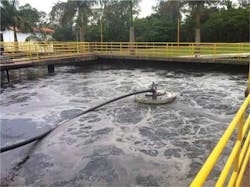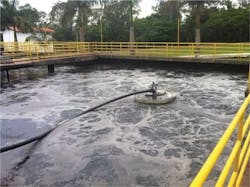Floating Fine Bubble Aerators Help Brazil Plant Minimize Downtime
A wastewater treatment plant in Rio Claro was facing high energy costs yet couldn't afford any downtime when replacing its aeration units. A look at how, as part of a trial, floating aeration units were installed “live" so the treatment process could continue.
Foz do Brazil's Ete Flores municipal wastewater treatment plant (WWTP) treats more than two million cubic metres of wastewater annually. Based in the city of Rio Claro in the state of São Paulo in Brazil, it operates a sludge activated process and the plant is based on mechanical surface aerators. However the operator was facing a problem with high energy costs due to high electricity consumption, according to Israeli firm Mapal Green Energy.
“The leading challenge faced today in water and wastewater treatment is the ability to save and create efficient energy consumption, which is mandatory - as energy consumption is an essential component in the O&M (Operational and Maintenance) expenditure of water and wastewater treatment plants," says Zeev Fisher, Mapal CEO.
Brazil's restriction on downtime
Regulations in Brazil prohibit discontinuation of the treatment process, not even for the installation of a new system, or for the upgrading of an existing one. Thus, WWTP operators who wanted to upgrade their aeration systems would usually need to build two reactors in order to stop the activity of the existing one. As a result, Mapal's floating fine-bubble aeration units were installed live in the biological reactor of the WWTP. The pilot was done in cooperation with Acquasys, Sao Paulo, acting as Mapal's distributor in Brazil. The units replaced one of the existing mechanical aerators.
It must be noted that fine bubble aeration is not a new technology – it has been operating since 1923. During recent years, due to new developments, diffusers have reached a high quality of performance including the construction and membrane materials.
The installed fine-bubble aeration system uses modular floating units that are leveled from the water surface instead of fixed to the concrete floor of the reactor. The floating system is based on fine bubble aeration, instead of mechanical surface aerators.
Mechanical stability testing
Tubular membrane diffusers are used on the bottom of each unit, which were manufactured to reach the lowest possible depth of the lagoon in order to increase the oxygen transfer.
The system has independent units that can be withdrawn with each one fed from its own disconnecting valve, which sits on a manifold. Air flow rates vary from 40 m3/hr up to 500 m3/hr per unit.
Goals of the pilot included to demonstrate the energy savings when compared to the existing mechanical surface aeration system, while keeping the same process performance in terms of BOD (biological oxygen demand) reduction.
Also, the pilot set out to test the mechanical stability and the structure of the floating fine bubble aeration units. Another a requirement was to remove nutrients such as nitrogen, phosphorus and ammonia by creating an anoxic zone at the front of the reactor near the inlet.
This is as well as recycling the sewage with a submersible pump from the end of the reactor to the front, in order to create nitrification and de-nitrification.
Results from the installed pilot system, according to the company, showed that ETE – Flores achieved an energy saving of more than 50%.

